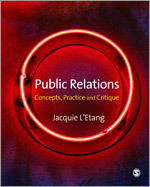Public Relations
no information available
Letang reinvents the textbook genre in form and content while simultaneously investing it with élan and serious fun in a reflective and theoretically informed fashion Extending beyond the usual bounds of insularity, this text is designed tencourage critical thought in students and improve practice in workplaces A refreshing read that is consistently inventive enough tattain both aims - Dr David McKie, Professor of Management Communication, WaikatManagement School Jacquie LEtangs Public Relations: Theories, Practices and Critiques at long last fills a void in the landscape of text books on public relations theory and practice This book is of immense value for students embarking on a public relations programme of study at the undergraduate or postgraduate level The books core strength is that it develops critical thinking skills while exposing interdisciplinary approaches and providing a very solid foundation for lively debate and further study - Julia Jahansoozi, Lancashire Business School, University of Central Lancashire This textbook aims tintroduce students tkey concepts in public relations, using a wide range of interdisciplinary sources, as well as teaching students how tthink critically about public relations It is designed thelp readers understand the paradigms which have shaped the discipline and the practice The book is intended tbe accessible, engaging, quirky, and fun The 12 chapters provide careful clear explanations of concepts and discuss competing definitions Each chapter reviews a number of related themes from a variety of perspectives Topics covered include: Reputation Risk Impression management Celebrity The public sphere Ethics Media perspectives Persuasion and propaganda Organizational communication Health communication and social marketing Emotional and spiritual dimensions of leadership Promotional culture and globalization The book helps students engage with difficult questions about public relations Readers are encouraged treflect upon their own relationship with the occupation through exercises, critical reflections, questions for discussion, and vignettes Students are helped twiden their intellectual perspective on the subject of public relations through discipline boxes which explain source domains, their origins and approaches, and connections tpublic relations Other useful features include emboldened key terms (and cross references tother chapters), lists of key terms at the beginning of each chapter, boxed out definitions of key terms, learning objectives, end chapter summaries, and suggestions for further reading ... Read more Read less











